- Joined
- Oct 9, 2007
- Messages
- 47,633 (7.44/day)
- Location
- Dublin, Ireland
| System Name | RBMK-1000 |
|---|---|
| Processor | AMD Ryzen 7 5700G |
| Motherboard | Gigabyte B550 AORUS Elite V2 |
| Cooling | DeepCool Gammax L240 V2 |
| Memory | 2x 16GB DDR4-3200 |
| Video Card(s) | Galax RTX 4070 Ti EX |
| Storage | Samsung 990 1TB |
| Display(s) | BenQ 1440p 60 Hz 27-inch |
| Case | Corsair Carbide 100R |
| Audio Device(s) | ASUS SupremeFX S1220A |
| Power Supply | Cooler Master MWE Gold 650W |
| Mouse | ASUS ROG Strix Impact |
| Keyboard | Gamdias Hermes E2 |
| Software | Windows 11 Pro |
Intel's upcoming "Clarkdale" is special for two reasons: it is the first 32 nm based processor from Intel, and that it's the first processor that comes with a graphics processor built in, something AMD conceptualized a long time ago. Under the hood (read: integrated heat-spreader), Clarkdale is a busy package, that holds a CPU complex die (that houses the main processing cores, cache, a dual-channel DDR3 integrated memory controller, and a Quickpath interconnect controller, that connects the die to its neighbor, a northbridge-iGraphics die that houses most northbridge components including a PCI-Express 2.0 root complex, the star-attraction IGP and a DMI connection to the "platform controller hub (PCH)".

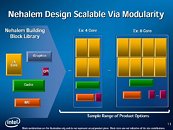
As the industry is gearing up for a gala launch of the socket LGA-1156 platform, almost every processor and motherboard making news leaves out the iGraphics component of these processors, simply because the first LGA-1156 processors to hit the scene, the quad-core "Lynnfield" lacks an IGP, and that it's much talked about sidekick the P55 chipset lacks the necessary component that lets the platform make use of the IGP. Dubbed Intel Flexible Display Interface (FDI), a component links the IGP to its display connectors on the board. Other members in Intel's upcoming 5-series chipsets, namely H55, H57, and Q55 as detailed earlier, feature FDI.
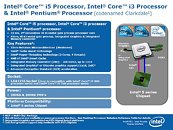
The IGP itself uses a fairly conventional design, and focuses on essentially light 3D, and HD video acceleration, as today's consumer OSes are using user interfaces that heavily make use of hardware 3D acceleration, and more applications are using light 3D. With this being the generation that's moving towards HD video, it's a good idea to have at least an IGP that has what it takes to support all industry HD video standards for smooth playback. The IGP is DirectX 10 Shader Model 4.0 compliant, for starters, so it might technically be eligible to accelerate compute shader applications.
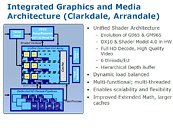
Back when the processor model number scheme of Intel's Clarkdale-based dual-core processors first surfaced, the presence of a "Core i5 661" with the same specifications as the "Core i5 660" baffled us. The missing piece of the puzzle turned out to be its IGP, which has a higher core speed of 900 MHz. Other Core i5 and Core i3 "Clarkdale" processors have their IGPs running at 733 MHz instead. As a result of this seemingly small speed-bump, the overall processor TDP shoots up from 73W to 89W. Pentium G6950 has a much lower IGP core speed of 533 MHz, though it doesn't affect the TDP one bit. So there's more to it than IGP speeds.
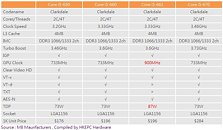
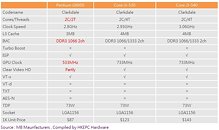
Finally, it boils down to performance. The Clarkdale IGP was pitted against Intel GMA X4500HD that's found on current Intel G45 chipset, and NVIDIA GeForce 9400 found on some high-end MCP7A-based motherboards, including the ION platform. While the superior graphics processing capabilities of the GeForce 9400 makes it almost inconsequential, the Clarkdale IGP performs almost twice as fast as GMA X4500HD overall. With HD video playback tests, the objective is to measure CPU usage. Lower the usage, the better. While the GeForce 9400 took the lead in most tests, again, the Clarkdale IGP outperformed its predecessor. It aced the Dual Stream H.264 20Mbps test with the lowest CPU usage.


With P55 and Lynnfield hogging most of the limelight, not much more is known about the IGP+H5x platform. Hopefully, we get to know more in Q1 2010, when Intel plans its second big wave of CPU launches.
View at TechPowerUp Main Site


As the industry is gearing up for a gala launch of the socket LGA-1156 platform, almost every processor and motherboard making news leaves out the iGraphics component of these processors, simply because the first LGA-1156 processors to hit the scene, the quad-core "Lynnfield" lacks an IGP, and that it's much talked about sidekick the P55 chipset lacks the necessary component that lets the platform make use of the IGP. Dubbed Intel Flexible Display Interface (FDI), a component links the IGP to its display connectors on the board. Other members in Intel's upcoming 5-series chipsets, namely H55, H57, and Q55 as detailed earlier, feature FDI.

The IGP itself uses a fairly conventional design, and focuses on essentially light 3D, and HD video acceleration, as today's consumer OSes are using user interfaces that heavily make use of hardware 3D acceleration, and more applications are using light 3D. With this being the generation that's moving towards HD video, it's a good idea to have at least an IGP that has what it takes to support all industry HD video standards for smooth playback. The IGP is DirectX 10 Shader Model 4.0 compliant, for starters, so it might technically be eligible to accelerate compute shader applications.

Back when the processor model number scheme of Intel's Clarkdale-based dual-core processors first surfaced, the presence of a "Core i5 661" with the same specifications as the "Core i5 660" baffled us. The missing piece of the puzzle turned out to be its IGP, which has a higher core speed of 900 MHz. Other Core i5 and Core i3 "Clarkdale" processors have their IGPs running at 733 MHz instead. As a result of this seemingly small speed-bump, the overall processor TDP shoots up from 73W to 89W. Pentium G6950 has a much lower IGP core speed of 533 MHz, though it doesn't affect the TDP one bit. So there's more to it than IGP speeds.


Finally, it boils down to performance. The Clarkdale IGP was pitted against Intel GMA X4500HD that's found on current Intel G45 chipset, and NVIDIA GeForce 9400 found on some high-end MCP7A-based motherboards, including the ION platform. While the superior graphics processing capabilities of the GeForce 9400 makes it almost inconsequential, the Clarkdale IGP performs almost twice as fast as GMA X4500HD overall. With HD video playback tests, the objective is to measure CPU usage. Lower the usage, the better. While the GeForce 9400 took the lead in most tests, again, the Clarkdale IGP outperformed its predecessor. It aced the Dual Stream H.264 20Mbps test with the lowest CPU usage.


With P55 and Lynnfield hogging most of the limelight, not much more is known about the IGP+H5x platform. Hopefully, we get to know more in Q1 2010, when Intel plans its second big wave of CPU launches.
View at TechPowerUp Main Site











